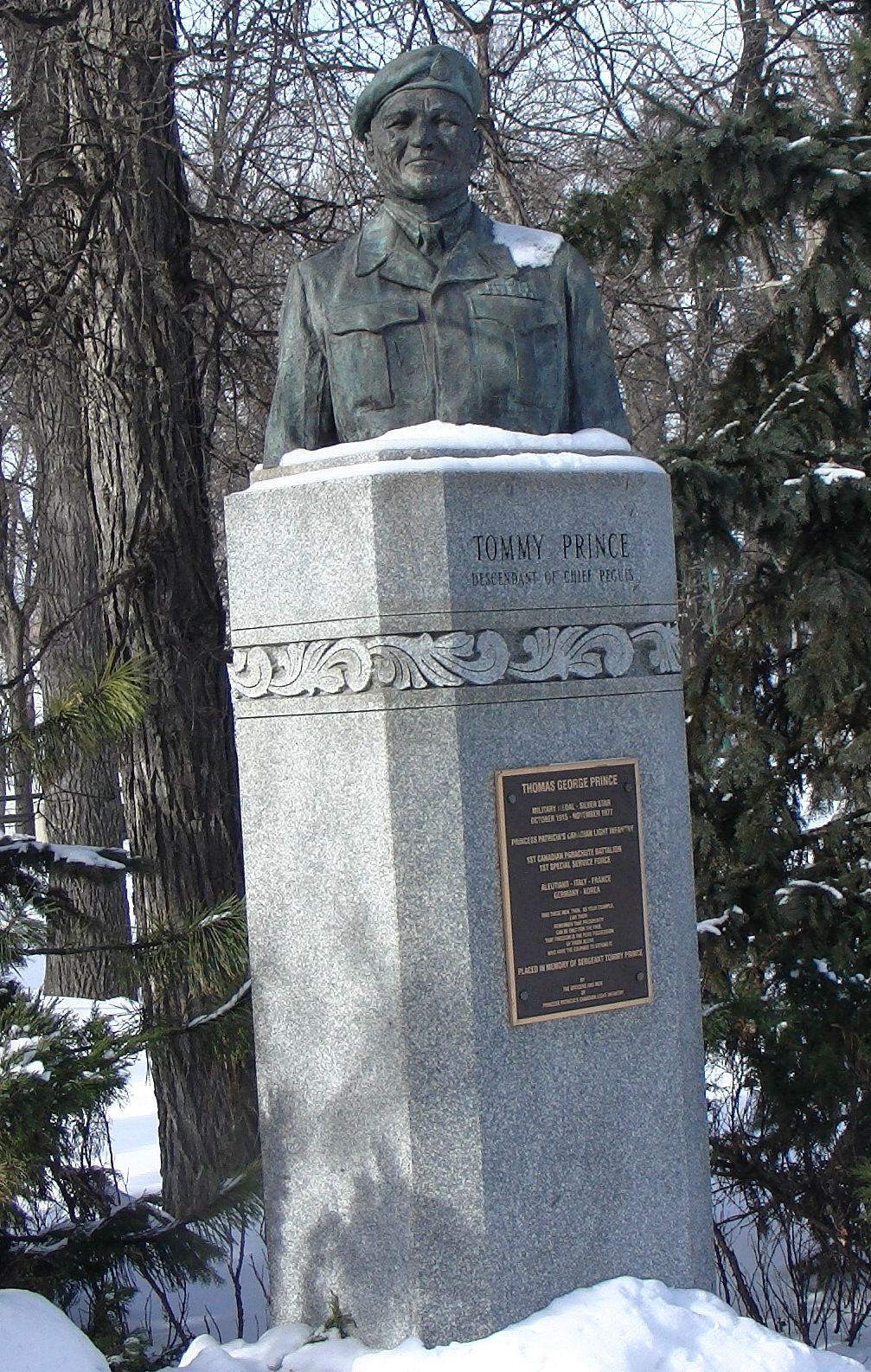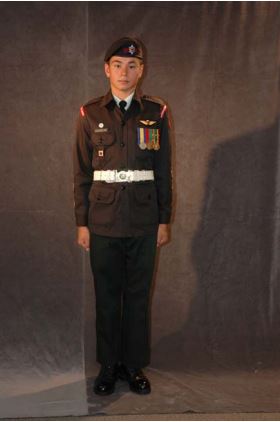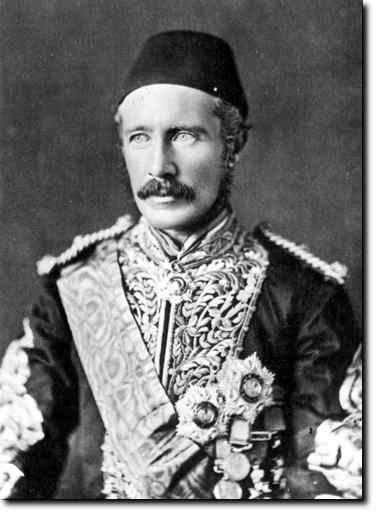|
Tommy Prince
Thomas George Prince MM SSM (October 25, 1915 – November 25, 1977) was an Indigenous Canadian war hero and the most decorated soldier in the First Special Service Force or Devil's Brigade during World War II. He was Canada's most decorated First Nations soldier, serving in World War II and the Korean War. Prince's military deeds as a scout and as a forward combatant were unique and of major strategic importance. Tommy Prince was descended from First Nations chiefs who had negotiated treaty rights with representatives of The Crown, and Prince himself would also represent First Nations concerns in Ottawa as Chairman of the Manitoba Indian Association (currently Assembly of Manitoba Chiefs) delegation. He advocated for the abolition of the governing Indian Act in Canada and proposed respect for the traditional Crown treaties as the basis of First Nations rights. Prince's position, although considered radical at the time, has been vindicated in subsequent decades by Supreme Court ... [...More Info...] [...Related Items...] OR: [Wikipedia] [Google] [Baidu] |
Manitoba
Manitoba ( ) is a Provinces and territories of Canada, province of Canada at the Centre of Canada, longitudinal centre of the country. It is Canada's Population of Canada by province and territory, fifth-most populous province, with a population of 1,342,153 as of 2021, of widely varied landscape, from arctic tundra and the Hudson Bay coastline in the Northern Region, Manitoba, north to dense Boreal forest of Canada, boreal forest, large freshwater List of lakes of Manitoba, lakes, and prairie grassland in the central and Southern Manitoba, southern regions. Indigenous peoples in Canada, Indigenous peoples have inhabited what is now Manitoba for thousands of years. In the early 17th century, British and French North American fur trade, fur traders began arriving in the area and establishing settlements. The Kingdom of England secured control of the region in 1673 and created a territory named Rupert's Land, which was placed under the administration of the Hudson's Bay Company. Rupe ... [...More Info...] [...Related Items...] OR: [Wikipedia] [Google] [Baidu] |
Brokenhead Ojibway Nation
Brokenhead Ojibway Nation (BON, oj, Baaskaandibewi-ziibiing, meaning ''at the brokenhead River'') is an Anishinaabe (Saulteaux/Ojibwa) First Nation located approximately northeast of Winnipeg, Manitoba. The main reserve of Brokenhead 4 is surrounded by the Rural Municipality of St. Clements, except for a small lakeshore on Lake Winnipeg. Reserves The First Nation have reserved for themselves three reserves: * Birch Landing () — totalling a size of ; surrounded by the Rural Municipality of Alexander. * Brokenhead 4 — serves as their main reserve, totalling a size of ; it is surrounded by the Rural Municipality of St. Clements and contains the settlement of Scanterbury, Manitoba. * Na-Sha-Ke-Penais () — totalling a size of ; surrounded by East St. Paul. Brokenhead 4 Brokenhead 4 serves as the main reserve of Brokenhead Ojibway Nation. It is situated along Manitoba Highway 59 (PTH 59), with Winnipeg located to its south and Grand Beach, Patricia Beach, and Victoria ... [...More Info...] [...Related Items...] OR: [Wikipedia] [Google] [Baidu] |
Royal Canadian Army Cadets
The Royal Canadian Army Cadets (RCAC; french: Cadets royaux de l’Armée canadienne) is a national Canadian youth program sponsored by the Canadian Armed Forces and the civilian Army Cadet League of Canada. Under the authority of the National Defence Act, the program is administered by the Canadian Armed Forces and funded through the Department of National Defence. Additionally, the civilian partner of the Royal Canadian Army Cadets, the Army Cadet League of Canada, also ensures financial, accommodations and transportation support for RCAC programs and services at a community level. Many Royal Canadian Army Cadet corps receive logistical assistance and administrative support from their affiliated Regular Force or Reserve Force unit. While cadets may wear the badges and accoutrements of their affiliated unit, cadets are not members of the Canadian Armed Forces. With roots in the early drill associations authorized in 1861, Royal Canadian Army Cadets is Canada's oldest youth pr ... [...More Info...] [...Related Items...] OR: [Wikipedia] [Google] [Baidu] |
Canadian Indian Residential School System
In Canada, the Indian residential school system was a network of boarding schools for Indigenous peoples. The network was funded by the Canadian government's Department of Indian Affairs and administered by Christian churches. The school system was created to isolate Indigenous children from the influence of their own native culture and religion in order to assimilate them into the dominant Canadian culture. Over the course of the system's more than hundred-year existence, around 150,000 children were placed in residential schools nationally. By the 1930s, about 30 percent of Indigenous children were attending residential schools. The number of school-related deaths remains unknown due to incomplete records. Estimates range from 3,200 to over 30,000, mostly from disease. The system had its origins in laws enacted before Confederation, but it was primarily active from the passage of the '' Indian Act'' in 1876, under Prime Minister Alexander MacKenzie. Under Prime Minister ... [...More Info...] [...Related Items...] OR: [Wikipedia] [Google] [Baidu] |
Indian Reserve
In Canada, an Indian reserve (french: réserve indienne) is specified by the '' Indian Act'' as a "tract of land, the legal title to which is vested in Her Majesty, that has been set apart by Her Majesty for the use and benefit of a band." Indian reserves are the areas set aside for First Nations, an indigenous Canadian group, after a contract with the Canadian state ("the Crown"), and are not to be confused with land claims areas, which involve all of that First Nations' traditional lands: a much larger territory than any reserve. Demographics A single "band" (First Nations government) may control one reserve or several, while other reserves are shared between multiple bands. In 2003, the Department of Indian and Northern Affairs stated there were 2,300 reserves in Canada, comprising . According to Statistics Canada in 2011, there are more than 600 First Nations/Indian bands in Canada and 3,100 Indian reserves across Canada. Examples include the Driftpile First Nation, wh ... [...More Info...] [...Related Items...] OR: [Wikipedia] [Google] [Baidu] |
Siege Of Khartoum
The Siege of Khartoum (also known as the Battle of Khartoum or Fall of Khartoum) occurred from 13 March 1884 to 26 January 1885. Sudanese Mahdist forces captured the city of Khartoum from its Egyptian garrison, thereby gaining control over the whole of Sudan. Egypt had controlled Sudan since 1820, but had itself come under British domination in 1882. In 1881, the Mahdist Revolt began in Sudan, led by Muhammad Ahmad who claimed to be the Mahdi. The Egyptian army was unable to suppress the revolt, being defeated in several battles and retreating to their garrisons. The British refused to send a military force to the area, instead appointing Charles George Gordon as Governor-General of Sudan, with orders to evacuate Khartoum and the other garrisons. Gordon arrived in Khartoum in February 1884, where he found it impossible to reach the other garrisons which were already besieged. Rather than evacuating immediately, Gordon began to fortify the city, which was cut off when the local ... [...More Info...] [...Related Items...] OR: [Wikipedia] [Google] [Baidu] |
Nile Expedition
The Nile Expedition, sometimes called the Gordon Relief Expedition (1884–85), was a British mission to relieve Major-General Charles George Gordon at Khartoum, Sudan. Gordon had been sent to the Sudan to help Egyptians evacuate from Sudan after Britain decided to abandon the country in the face of a rebellion led by self-proclaimed Mahdi, Mahommed Ahmed. A contingent of Canadians was recruited to help the British navigate their small boats up the Nile River. The Nile Expedition was the first overseas expedition by Canadians in a British imperial conflict, although the Nile Voyageurs were civilian employees and did not wear uniforms. The expedition was commanded by Garnet Wolseley. After Commander Herbert Stewart was mortally wounded, Brigadier-General Charles William Wilson took command of an advance party of about 1,400 men. On two Nile steamers Wilson's Desert Column reached Khartoum in the afternoon of 28 January 1885. It came two days too late: Khartoum had been seize ... [...More Info...] [...Related Items...] OR: [Wikipedia] [Google] [Baidu] |
Red River Rebellion
The Red River Rebellion (french: Rébellion de la rivière Rouge), also known as the Red River Resistance, Red River uprising, or First Riel Rebellion, was the sequence of events that led up to the 1869 establishment of a provisional government by Métis leader Louis Riel and his followers at the Red River Colony, in the early stages of establishing today's Canadian province of Manitoba. It had earlier been a territory called Rupert's Land and been under control of the Hudson's Bay Company before it was sold. The event was the first crisis the new federal government faced after Canadian Confederation in 1867. The Canadian government had bought Rupert's Land from the Hudson's Bay Company in 1869 and appointed an English-speaking governor, William McDougall. He was opposed by the French-speaking mostly-Métis inhabitants of the settlement. Before the land was officially transferred to Canada, McDougall had sent out surveyors to plot the land according to the square township sys ... [...More Info...] [...Related Items...] OR: [Wikipedia] [Google] [Baidu] |
Treaty 2
''Treaty 2'' was entered in to on 21 August 1871 at Manitoba House, Rupertsland, with representatives of the Queen of Great Britain and Ireland. The original Anishinaabe (Chippewa and Cree), who were present, constitute ''Treaty 2'' today. It is known that many of the chiefs and leaders within the territory were at the early gathering and after the treaty was agreed to. Those who were not present were represented through Metis until they indicated where they wished their farming reserves to be established. The treaty reaffirmed the inherent rights that the Anishinaabe had prior to European contact, located where southwestern Manitoba is today and a small part of southeastern Saskatchewan. History This was the second treaty made since the formation of the modern Canadian government in 1867, and one year after the province Manitoba joined the Canadian Confederation. Manitoba was not a province located in ''Treaty 2'' at the time the treaty was made. The ''Manitoba Act'' was amen ... [...More Info...] [...Related Items...] OR: [Wikipedia] [Google] [Baidu] |
Treaty 1
''Treaty 1'' (also known as the "Stone Fort Treaty") is an agreement established on August 3, 1871, between the Imperial Crown of Great Britain and Ireland and the Anishinabe and Swampy Cree nations. The first of a series of treaties called the Numbered Treaties that occurred between 1871–1921, this accord has been held to be essentially about peace and friendship. However, the eight days of treaty-making ended with the indigenous groups agreeing to "cede, release, surrender and yield up to Her Majesty the Queen and successors forever all the lands" in southern Manitoba to the Crown, in exchange for an annual annuity and material goods such as clothing and agricultural supplies. Within a year of the agreement, however, the indigenous communities approached the Canadian government declaring that a number of the items promised, which would become known as the “Outside Promises”, within the treaty had not been handed over to them yet, although subjects of the Crown continued t ... [...More Info...] [...Related Items...] OR: [Wikipedia] [Google] [Baidu] |
Henry Prince (chief)
Henry Prince ( c. 1819 – June 7, 1899), born Pa-bat-or-kok-or-sis or Mis-koo-kenew ('Red Eagle'), was a Saulteaux Indian chief of the Peguis First Nation. Early life Pa-bat-or-kok-or-sis was born in a settlement along the banks of the Netley Creek about down river from future site of the St. Peter's Church and settlement (approx. 1837), to Chief Peguis and Victoria, one of his wives. He attended school at a one-room schoolhouse operated out of the St. Peter's Church, and was baptized Henry Prince in 1837. In 1840, he married Sarah Badger, with whom he had at least 6 children. In 1864, after the death of his father, he became Chief of the St. Peter's Indian Band (later called the Peguis First Nation). As Chief On November 6, 1869, shortly after Louis Riel took control of Upper Fort Garry as part of the Red River Rebellion, he issued an invitation to the parishes of the English speaking settlers north of the Forks to a meeting, in an attempt to gain their support. Chief H ... [...More Info...] [...Related Items...] OR: [Wikipedia] [Google] [Baidu] |
Saulteaux
The Saulteaux (pronounced , or in imitation of the French pronunciation , also written Salteaux, Saulteau and other variants), otherwise known as the Plains Ojibwe, are a First Nations band government in Ontario, Manitoba, Saskatchewan, Alberta and British Columbia, Canada. They are a branch of the Ojibwe who pushed west. They formed a mixed culture of woodlands and plains Indigenous customs and traditions. Ethnic classification The Saulteaux are a branch of the Ojibwe Nations within Canada. They are sometimes called the Anihšināpē (Anishinaabe). ''Saulteaux'' is a French term meaning "people of the rapids," referring to their former location in the area of Sault Ste. Marie. They are primarily hunters and fishers, and when still the primary dwellers of their sovereign land, they had extensive trading relations with the French, British and later Americans at that post. Location The Saulteaux historically were settled around Lake Superior and Lake Winnipeg, principal ... [...More Info...] [...Related Items...] OR: [Wikipedia] [Google] [Baidu] |







